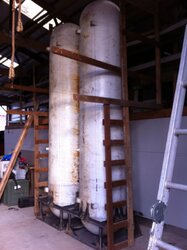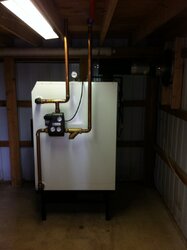When I look back at what motivated my decision, and I barely had any knowledge other than an OWB was not even a consideration, I investigated the Garn primarily, but then saw a Tarm Solo Plus 40 at a trade show. That led to study on the Tarm-type gasification boiler with storage. My initial install was in my barn-shop, and I felt pretty sure that in the future I would build a new shop, so three things caused me to buy the Tarm over the Garn: 1) I would be moving the boiler/storage in the future and I wanted to be able to handle this my self without hiring someone with big equipment; thus the Garn had a big minus because I would not be able to move it myself; 2) a Tarm dealer was close to me, was the dealer who had the Tarm at the trade show, and the dealer offered me a good deal including delivery, and that sealed the deal; and 3) the Tarm had an excellent reputation and had been in the market for a long time.
Very glad I made the decision I did, as I now have a new shop, I moved the boiler (had help with the 1000 gal LP tank storage), and the Tarm has been trouble free since its first winter in 2007-08. Wood burned is nearly all pine, plus some aspen.
My first storage was 3 - 275 gallon used oil tanks, open storage -- big mistake with the oil tanks combined with my inexperience. Then the 1000 gal LP tank, could not have made a better choice, and if possible I would recommend closed, pressurized storage over open, unpressurized storage. A very important reason is that the system is sealed and maintenance free, but even more important I can load storage up to 193F and with my in-floor radiant which uses mixed down 100F water, I can get at least two days of heat and burn every other day, even with temps into the -30 to 40F range, and in milder weather easily get 3-5 days between burns. Whether you can do this will depend on your heat load; my heat load during winter ranges roughly between 10,000 to 18,000 btuh maximum.
I learned many things the hard way, so do your best to make sure that you do the install right the first time: hydronic heat is all about moving hot water, flow rates, pump head, properly sized plumbing and circulators, all to meet the required heat load economically and efficiently. While this isn't rocket science, doing it right takes a lot of knowledge or a whole lot of luck, something with which I was not blessed. I have re-done my system 3 times and now it is about right, although this summer I may redo and simplify the extra controls I added for my own convenience and for purposes of monitoring, data logging and lots of reporting on this forum.
Good luck, you certainly seem headed in the right direction.
 FWIW until you've seen -54 on the thermometer you don't know cold. This happened about 20yrs ago, before Al Gore talked about global warming. BTW this has been coldest winters in a long time
FWIW until you've seen -54 on the thermometer you don't know cold. This happened about 20yrs ago, before Al Gore talked about global warming. BTW this has been coldest winters in a long time FWIW until you've seen -54 on the thermometer you don't know cold. This happened about 20yrs ago, before Al Gore talked about global warming. BTW this has been coldest winters in a long time
FWIW until you've seen -54 on the thermometer you don't know cold. This happened about 20yrs ago, before Al Gore talked about global warming. BTW this has been coldest winters in a long time

 Ya, ya, ya. I would be willing to bet we have had more colder nights here than you have at your place this season and most seasons. And I hope I never see -54 on the thermometer! So there!
Ya, ya, ya. I would be willing to bet we have had more colder nights here than you have at your place this season and most seasons. And I hope I never see -54 on the thermometer! So there!  !!
!!



